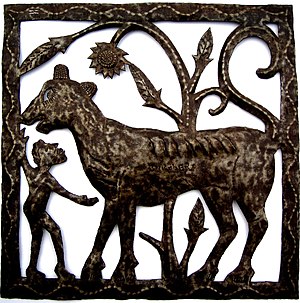The Tiger, the Brahmin and the Jackal

The Tiger, the Brahmin and the Jackal is a popular Indian folklore with a long history and many variants. The earliest record of the folklore was included in the Panchatantra, which dates the story between 200 BCE and 300 CE.
Mary Frere included a version in her 1868 collection of Indian folktales, Old Deccan Days,[1] the first collection of Indian folktales in English.[2] A version was also included in Joseph Jacobs' collection Indian Fairy Tales.[3]
Plot[edit]
A Brahmin (a member of the priesthood class) passes a tiger in a trap. The tiger pleads for his release, promising not to eat the Brahmin. The Brahmin sets him free but no sooner is the tiger out of the cage then he says he is going to eat the Brahmin, going back on his promise. The Brahmin is horrified and tells the tiger how unjust he is. They agree to ask the first three things they encounter to judge between them. The first thing they encounter is a tree, who, having suffered at the hands of humans, answers that the tiger should eat the Brahmin. Next a buffalo, exploited and mistreated by humans, agrees it is only just that the Brahmin should be eaten. Finally they meet a jackal who, sympathetic to the Brahmin's plight, at first feigns incomprehension of what has happened and asks to see the trap. Once there he claims he still doesn't understand. The tiger gets back in the trap to demonstrate and the jackal quickly shuts him in, suggesting to the Brahmin that they leave matters thus.
Variants[edit]

There are more than a hundred versions of this tale [4] spread across the world. In some the released animal is a crocodile, in some a snake,[5] a tiger[6] and in others a wolf.
Folklorist Joseph Jacobs stated that the tale can be found in early Indian sources.[7] Some variants are very old, going back at least to the Panchatantra or Fables of Bidpai[citation needed] and the Jataka tales. In Europe, it appeared some 900 years ago in the Disciplina Clericalis of Petrus Alphonsi, and later in the Gesta Romanorum and in the Directorium Vitae Humanae of John of Capua.[8]
There are also modern illustrated versions of the tale, such as The Tiger, the Brahmin & the Jackal[9] illustrated by David Kennett and The Tiger and the Brahmin[10] illustrated by Kurt Vargo. Rabbit Ears Productions produced a video version of the last book, narrated by Ben Kingsley, with music by Ravi Shankar.[11] The variant by Rabbit Ears Productions alters certain bits of the story, where the Brahmin travels alone to gain the opinion of others. An elephant is included as first of the three things (the latter two being the tree and water buffalo) that the Brahmin encounters.
See also[edit]
Notes[edit]
- ^ Frere, Mary (1896). . – via Wikisource.
- ^ Dorson, R. M. (1999). History of British folklore. Taylor and Francis. ISBN 0-415-20476-3. p. 334.
- ^ Jacobs, Joseph (1892). Indian Fairy Tales (1913 ed.). Forgotten Books. pp. 69–73. ISBN 1-60506-119-0. where it appears as The Tiger, the Brahman, and the Jackal. Jacobs gives his source as "Steel-Temple, Wideawake Stories, pp. 116-20; first published in Indian Antiquary, xii. p. 170 seq." It can be found online here at Google Books and here Archived 2011-07-11 at the Wayback Machine with its illustration.
- ^ Jacobs in his notes on the tale mentions that "No less than 94 parallels are given by Prof. K. Krohn in his elaborate discussion of this fable in his dissertation, Mann und Fuchs, (Helsingfors, 1891), pp. 38-60"
- ^ World Tales by Idries Shah has a version called The Serpent collected in Albania. The Farmer and the Viper is a more minimal Aesop's fable.
- ^ See Ingratitude Is the World's Reward: folktales of Aarne-Thompson-Uther type 155 for examples. Other examples include the Mexican story of Judge Coyote found in Creeden, Sharon (1994). Fair is Fair: World Folktales of Justice. august house. pp. 67–69. ISBN 0-87483-400-7.accessible in Google Books, There is No Truth in the World, found in Ben-Amos, Dan; et al. (2006). Folktales of the Jews: Tales from Eastern Europe. Jewish Publication Society. pp. 288–290. ISBN 0-8276-0830-6. accessible in Google Books.
- ^ Jacobs, Joseph. Europa's Fairy Book. New Tork and London: G. P. Putnam's Sons. 1916. p. 254.
- ^ Shah, Idries (1991). World Tales. Octagon Press. p. 265. ISBN 0-86304-036-5.
- ^ Lock, Kath (1995). The Tiger, the Brahmin & the Jackal. Era Publications. ISBN 1-86374-078-3.
- ^ Gleeson, Brian (1992). The tiger and the brahmin. illustrated by Kurt Vargo. Neugebauer Press. ISBN 0-88708-233-5.
- ^ See Rabbit Ears Productions media and release information.
